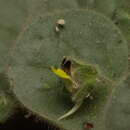en
names in breadcrumbs


Kickxia spuria, also commonly known as a round-leaved cancerwort, can be found in: AL , CA , FL , KY , MO , NC , NJ , NY , OH , OR , PA , RI , and WI (NatureServe, 2015). Kickxia spuria is native to Europe and Asia (NatureServe, 2015). Kickxia spuria is considered to be a non-native weed in the United States (Latzel, Dospelova & Klimesova, 2009: 928).
Kickxia spuria is an herbaceous plant that can be found in fields and disturbed open areas (Ontaria Wild Flowers 2015).Kickxia spuria’s common name refers to its circular-shaped leaves (NatureServe, 2014). This plant has hairy stems and leaves (Latzel, Dospelova & Klimesova, 2009: 925). The round leaves have a length of 10 to 30 mm (Go Botany, 2015). The flowers are fluorescent yellow with purple hues, and have a length of 3 to 5 mm (Go Botany, 2015). The flower when fully bloomed faces downward (NatureServe, 2014).Kickxia spuria flowers during the summer and autumn months (Ontaria Wild Flowers, 2015).
Kickxia spuria is a very aggressive plant (Latzel, Dospelova & Klimesova, 2009: 928). By studying the different ways Kickxia spuria can be injured, the most effective way can be used to control weed populations to protect other vegetation (Latzel, Dospelova & Klimesova, 2009: 928).An experiment to analyze the regenerative abilities was conducted in the University of South Bohemia. Kickxia spuria seeds were placed in two groups of five, one group was injured and the other group was not (Latzel, Dospelova & Klimesova, 2009: 924). The five injured specimens had tissue removed below the cotyledons (Latzel, Dospelova & Klimesova, 2009: 924). Kickxia spuria that grew back after being injured had shorter branches and fewer branches per stem (Latzel, Dospelova & Klimesova, 2009: 925). Kickxia spuria was calculated to have 87% regeneration after injury, which means that this little herbaceous plant is hardy (Latzel, Dospelova & Klimesova,2009: 925). This study is important because the results can be applied to weed management (Latzel, Dospelova & Klimesova, 2009: 928).
The oil from Kickxia spuria contains a number of different chemicals (Morteza-Semnani, Saeedi & Akbarzadeh, 2008: 24). From individuals collected in Iran, Kickxia spuria contains fourteen sesquiterpenoids from a class of terpenes considered as an organic compound made up of 47.5% of the flowering plant, which protects the plant from pathogenic funguses (Morteza-Semnani, Saeedi & Akbarzadeh, 2008: 25).